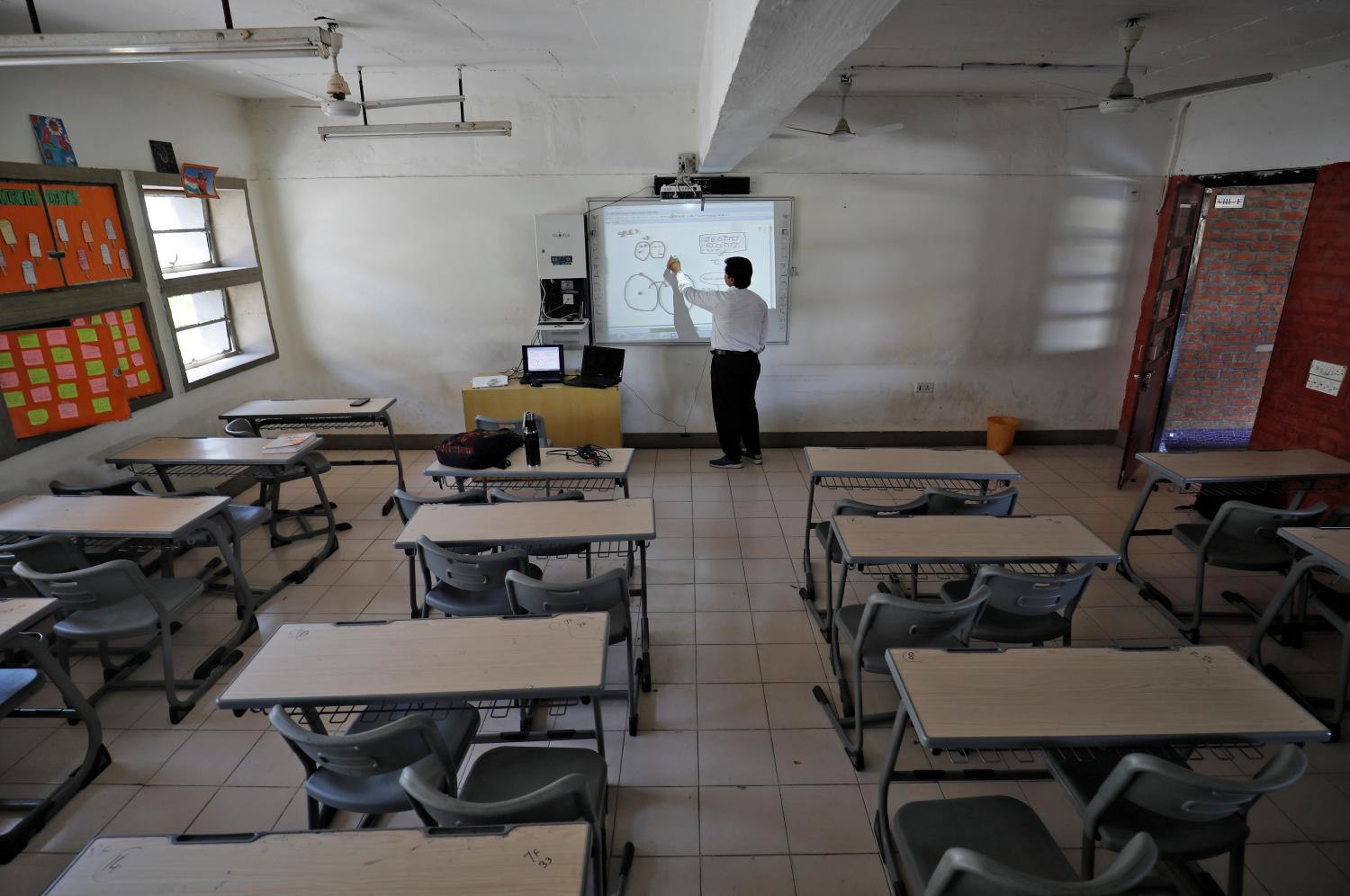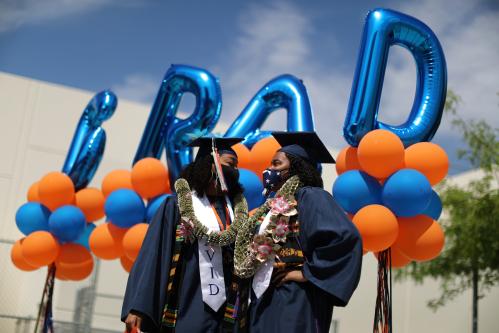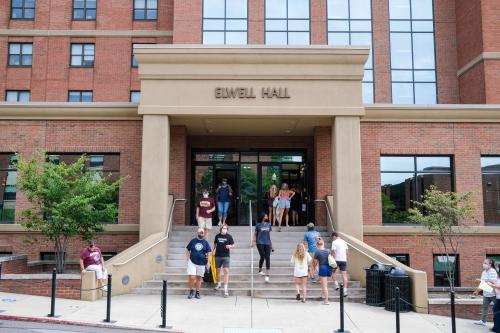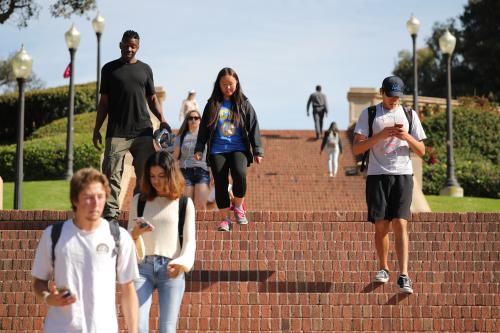With the growing outbreak of COVID-19, also known as the coronavirus, universities around the U.S. are canceling in-person classes, clamping down on travel, and sending students home. Protecting the health of students and staff, and limiting community transmission, is the most important priority.
After taking care of emergency measures, universities need to be making administrative and financial decisions over the next few weeks that depend on projections about what’s going to be happening three to six months from now. Economists call this “dynamic programming,” but that’s just a fancy name for thinking ahead. While there are many issues that require thinking ahead, here I’m going to focus specifically on issues involving international students, and the complications that arise due to international travel restrictions imposed indefinitely to counter the further spread of the coronavirus.
Before we begin, where are the international students?
The chart shows the number of international students—college students who are neither American citizens nor resident aliens studying in the United States—as a fraction of total enrollment. The figures here are based on undergraduate, full-time enrollment for fall 2018, and reflect approximations rather than exact numbers. While there are some a few states with few international students, international students make up a substantial part of total enrollment in much of America. They constitute over 5% of enrollment in the majority of states, and that share is especially high in D.C. and Massachusetts.
Let’s now look ahead to the beginning of the upcoming fall term, about six months from now. Will the coronavirus be under control? Will international travel restrictions be lifted? We all hope so, but there’s no real way to know. Will COVID-19 be over by the beginning of the summer term? Hopefully yes, but probably no. What are the time-critical decisions that need to be made in advance of resolution of the pandemic?
- Graduate admission reply date (April 15): Graduate schools in the U.S. nearly uniformly require students to reply to acceptance letters by April 15. (Some professional schools are earlier.) It might be wise to offer students a later commit date, but because graduate admissions generally do not involve a financial deposit, this is probably not that important.
- Undergraduate admission reply date (May 1): Colleges almost always require undergraduates to commit to a school by May 1. Some financial deposit often is required, and students make a psychological commitment as well. By May 1, there is virtually no chance that students in other countries will know whether they will be able to come to the United States in the fall. (For example, American consular services in China are shut down. No one knows when applications for student visas will be accepted.) It might be very wise to make an upfront offer to refund student deposits if travel is still restricted in the future. Colleges could also provide other options, such as online classes until students can safely come to the U.S., or a promise that admissions can be deferred.
- End of spring term: What happens to the visa status of international students who graduate this spring? The issue is that it may not be wise—or safe—for students to return to their home countries this summer. Given travel restrictions, it might not even be possible. (You may have read about the Italian tourists in Ethiopia whose visas have expired and who are refusing to leave Ethiopia—which they feel is now safer than Italy. Now multiply that problem by hundreds of thousands of international students.) The general rule is that students must leave the country within 60 days after graduation (with some exceptions for students doing Optional Practical Training, or OPT). Universities cannot extend visas. But they should be intermediaries asking the federal government for extensions and keeping students informed. If extensions are not forthcoming, maybe universities need to be offering options for students to retain student status by continuing to take courses and delaying graduation.
- Summer school: This one cuts both ways. Most years, summer programs are very attractive to international students who want to try out the United States temporarily. Schools had better be planning for no students showing up from abroad this summer. On the flip side, there may be many current international students who would ordinarily go home during the summer who will be staying here this year. That might increase attendance, and perhaps the need for dorm space. And for that matter, universities may want to provide housing for international students who can’t go home this summer irrespective of whether they are taking summer courses.
Finally, there’s one more important consideration: What happens to university budgets if international students all stay home? Unlike the issues above, there are not many decisions to be made before we have an idea if international enrollments are going to plummet. Nonetheless, it is worth knowing how exposed budgets are to the downside risk of these travel restrictions.
All international students disappearing is a worst-case, very unlikely scenario. But just as a baseline, I’ve put together approximate numbers on how exposed colleges are in each state.
Nationwide, the amount of tuition plus required fees from international students tops $2.5 billion. California has over $400 million at risk; New York over $300 million; Massachusetts over $200 million. Only Alaska and Wyoming appear to have under $1 million dollars at risk, and even in those states the risk is just barely under $1 million.
The high fraction of tuition coming from international students reflects both the fact that there are many international students and the fact that, at least in public universities, international students pay nonresident tuition rates. Nonresident tuition rates at the University of California, for example, are two-and-a-half times the rate paid by Californians. What’s more, most schools offer far less financial aid to international students than to domestic students. In that sense, the numbers reported here understate the true impact on net tuition.
I offer two suggestions for policymakers outside colleges. First, if the federal government is going to be making bailout loans, include universities on the list. Second, state lawmakers should add helping out campuses to their COVID-19 response to-do list.
The majority of any lost tuition revenue will be at public colleges. And I can tell you that, at least at the University of California, administrators are taking whatever steps are needed to protect the health of the campus and the surrounding communities—even if so doing raises costs and cuts revenue. Help is going to be needed to minimize the financial damage to higher education programs in the coming months.
4/7/20 update: This post previously discussed each state’s percentage of total tuition that came from international students. Due to an unforeseen computational error, this section and its associated figure have been removed.
The Brookings Institution is committed to quality, independence, and impact.
We are supported by a diverse array of funders. In line with our values and policies, each Brookings publication represents the sole views of its author(s).









